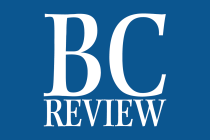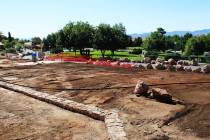Walton: ‘Not great news on the water front’
It was one of those cases in which the most important news came at the very end.
In the “council reports” section of the city council meeting where individual council members talk about their activities in the past two weeks, Councilman Steve Walton (who represents Boulder City on many of the important regional organizations including Southern Nevada Water Authority, the Colorado River Commission and Las Vegas Convention and Visitors Authority) had a couple of pieces of concerning news.
“It’s another rough year water-wise,” he began. “Average temperatures across the Colorado Basin are either the same or higher [than last year] for the most part. The snow-pack is far below average and our runoff is only a fraction of the snow-pack, because the dryness of the ground absorbs more of it and the heat evaporates it. So, not great news on the water front.”
Walton also reported on the substantial dip in international tourism and spending in Las Vegas. Keep in mind that the consolidated sales tax — largely driven by tourism spending — and the solar leases together make up more than three-quarters of Boulder City’s annual budget. More on this will appear in a future issue of the Review.
Walton’s river report may have been prescient as just a few days later it was announced that Nevada will face a 7% cut in its share of the Colorado River based on a reservoir projection released last week, marking the fifth year in a row of cuts in an era of concerning and increasing shortage.
As seven states and two countries squabble over the future of how 40 million people share the river, all signs point to less water in Lake Mead, Southern Nevada’s primary water source. And Friday’s projection from the U.S. Bureau of Reclamation affirms that by June 2027, Lake Mead is likely to fall to its shallowest level on record since the reservoir was filled in the 1930s.
“This underscores the importance of immediate action to secure the future of the Colorado River,” said David Palumbo, acting Reclamation Bureau commissioner, in a Friday statement. “We must develop new, sustainable operating guidelines that are robust enough to withstand ongoing drought and poor runoff conditions to ensure water security for more than 40 million people who rely on this vital resource.”
Ahead are tough choices and lingering questions about how the West can live with less, said Celene Hawkins, Colorado River program director with the Nature Conservancy, an environmental nonprofit.
“No one loves it from any angle because we’re all having to use less in the basin,” Hawkins said. “This is not an anomaly, and it’s showing the urgency for us to come together as a basin.”
Equipped for the future?
To prepare for such a sharp decline in reservoir storage as snow melt from the Rocky Mountains fails to deliver, Southern Nevada has been proactive about stretching its portion of the Colorado River.
Almost every drop of water used indoors is recycled and sent back to Lake Mead through extensive wastewater treatment.
Except in Boulder City.
In 2018, elected city leadership turned down an offer by SNWA to construct a pipeline to move BC’s wastewater into Henderson where it would flow into the recycling system. Under the leadership of former Mayor Kiernan McManus, the council decided that the pipeline was nothing more than a backdoor that would encourage additional housing development in Boulder City.
As a result, more than one million gallons of wastewater from Boulder City is dumped in the desert every day where it just evaporates. A new study sponsored by SNWA on options for remedying that situation has been in the works for well over a year.
Other sometimes controversial measures to reduce outdoor water use include charging high-use customers excessive use fees, providing rebates for homeowners to rip out their grass, and removing grass that a committee of experts has deemed nonfunctional.
And the measures have delivered some results. SNWA announced last week that consumptive water use from January to July —water that isn’t recycled — is down to 39 billion gallons. That’s 2 billion gallons less than the 2022-to-2024 average for water use in that period.
Again, Boulder City is an outlier.
“Water delivery through May 2025 was 3,161 acre feet, which is 7.9% higher than 2024,” Boulder City Utility Director Joe Stubitz told the Utility Advisory Committee at their most recent meeting in July. Stubitz said that, “The increase is likely weather related as the summer season usage typically increases.” However the increase between 2024 and 2025 included all of 2024 while the 2025 figure only included the spring of 2025.
Details sparse on state negotiations
The hydrological reality of the Colorado River Basin is underscored by a tense negotiation process in which seven states are running out of time to come to an agreement.
Current governing guidelines for how states share the river expire at the end of 2026, and negotiators have been less than forthcoming about specifics on interstate talks.
The most recent news is that the Lower Basin states of Nevada, California and Arizona are mulling a so-called “divorce” from the Upper Basin states of Colorado, New Mexico, Utah and Wyoming. Releases from Lake Powell into Lake Mead would be based on a three-year average of levels at Lees Ferry, Arizona, though no clarity has been offered on what a release structure could look like.
“It’s all in the details, which, of course, are the hard part,” said Haley Paul, Arizona policy director at the Audubon Society, a nonprofit dedicated to the habitat and health of birds. “Even if there’s still disagreement about the numbers, we have to acknowledge the reality that this river has less to give.”
















